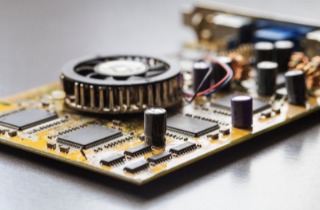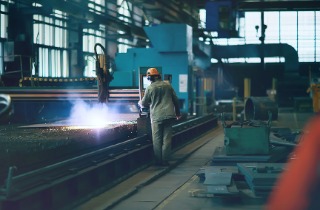Evolving IT and Its Significance in the Manufacturing Industry
Industry Insights | 11 April 2022 | Ratna Priya
The evolution of information technology has had a profound impact on the industrial landscape, particularly in the industrialized world’s manufacturing industry. IT’s function has shifted from that of a supporting component to that of an enabler. The construction of digital manufacturing processes and products has become the enabler of new advancements since IT has been combined with traditional manufacturing techniques.
Digital manufacturing clearly enables new opportunities from the production perspective but also from the collaboration perspective. As in the networked environment, it improves the ability to adapt and respond to the changing requirements internally and externally.
Cyber-physical systems connect machines and products in huge networks (CPSs)
Humans nowadays make decisions based on their process adaptation experience. These intelligent components can self-optimize their performance as the intelligence and complexity of the processes and products grows.
Because humans’ roles move toward coordinators and problem-solvers, labour work will shift but remain indispensable.


Heavy Asset Manufacturing: A Revolutionary Change in The Era
Ongoing maintenance of production machinery and equipment is a major expense when it comes to talk about the manufacturing industry
Heavy manufacturers have cleaned up their act on keeping operations efficient and all thanks to AI. They used to employ capital expenditures to fund upgrades by spending money on new equipment to replace malfunctioning equipment etc. AI is a less expensive alternative that allows organizations to
- 1. Analyse machine data more efficiently to develop preventative maintenance solutions
- 2. Replace manual monitoring operations by machine operators with automated AI decision-making on equipment state.
Benefits of having a robust IT infrastructure for discrete manufacturing companies
When there is no lag between material flow and information flow, manufacturing expenses are regulated and minimized. It is critical to have a robust information technology infrastructure in place, especially in the practice of demand-based manufacturing, where suppliers that offer accessories to OEMs use JIT (just-in-time) or in-line sequencing approaches.
Characteristics of a good IT information infrastructure
There are five tiers to a good IT information infrastructure in manufacturing. The ‘control systems layer,’ which directly regulates the equipment needed to produce the product, is the lowest level. The information acquired at this level is control data and the output signal generated by the device/equipment for specific input and controller.
The supervisory control layer,’ in which ‘Supervisory Controllers and Data Acquisition systems (SCADAs) are deployed for exercising supervisory control and acquiring process data and information, is the second level.
Manufacturing execution systems are the third layer, a ‘production management functional layer’ that includes product life cycle management (including computer-aided design), production scheduling, shipment of production orders, data collection on production orders, production monitoring and reporting, and tracking components and genealogy, and so on.
The fourth layer is the ‘plant to enterprise connection layer,’ which connects the plant’s business operations to the organization’s business processes. A business rules engine establishes the link between plant systems and enterprise systems for the purposes of information sharing, analysis, and reporting.
The ‘enterprise application layer,’ which contains all enterprise-level applications such as ERP, enterprise asset management, supply chain management, customer relationship management, and so on, is the final layer.
Better infrastructure will seamlessly connect each layer to the next, allowing all layers to communicate in real-time.
An Insight into this infrastructure’s goal
The central objective of this IT architecture is to achieve zero latency within and between business processes with stakeholders spread across the company.
Maintenance, for example, is a function that has an impact on production (due to the need for availability), inventory (for spares), purchasing (for spares, tools), finance (for budgeting, asset procurement, replacement, and so on), logistics (for scheduling, dispatching, and executing maintenance work orders), and corporate executive management (corporate strategy for ensuring low production costs).
‘Enabling a real-time enterprise’ refers to the concept of attaining a unified synthesis of existing business processes, knowledge, data, and other assets within a firm that are buried in various apps, divisions, and departments via a zero latency infrastructure.
A manufacturing company can use real-time enterprise infrastructure to help its management and employees maximize performance efficiency, production effectiveness, quality, and dependability, and thereby gain a competitive edge that leads to increased market share and higher shareholder returns.
Importance of predictive maintenance
With the employment of AI algorithms, a concept of predictive maintenance can be quite helpful to forecast when machinery and equipment may fail and thus actions can be recommended based o that. For continuous monitoring of equipment sensors, forecasting when they are likely to fail and offering proactive, condition-based maintenance regimens Artificial Intelligence (AI) may be trained. Deviations from material formulations, minor variations in equipment behaviour, and modifications in raw materials are all examples. As a result, there is less downtime and the equipment’s remaining useful life is extended.
Fostering Smart Factories and Enhancing Product Safety
Automobile tires are critical safety components, thus companies strive for perfection in terms of quality. To do this, the companies have developed a machine learning system that automates quality assurance, which is typically controlled by humans. The machine is controlled in real-time by the system, which employs sensors to measure 480 quality items. By eliminating bottlenecks in the moulding process, product homogeneity was increased by 15% over the human-controlled process, and productivity was doubled.
Machine learning will also be at the crux of smart industries of the future. Nokia, for example, recently created a video app that uses machine learning to warn industrial operators when there are irregularities in the production process, enabling them to be rectified in real-time. With a 5G network, the production system can report problems directly to the data centre.
Rise High with AI skillsets today
Any modification which has given miraculous results to growing industries today and has become the heart of even the manufacturing industry is undoubtedly AI and can be predicted as an integral part of enormous industries in coming days. Providing a boost to this industry, it is quintessential to train AI engineers who can create a practical application using a wide range of intelligent agents as skillsets are still in short supply.
Machine learning experts who are trained in supervised and unsupervised learning, mathematical and heuristic techniques, and deep learning experts who gain knowledge to master TensorFlow, the open-source software library designed to conduct machine learning and deep neural network research, has major significance in training.




















